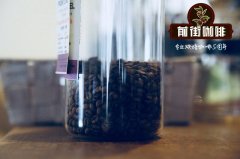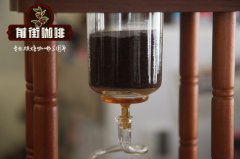The difference between high-quality coffee beans and commercial beans what are the advantages of fine coffee beans and commercial beans?

Professional coffee knowledge exchange more coffee bean information please follow the coffee workshop (Wechat official account cafe_style)
Coffee beans are mainly divided into three types: Arakabi, Robasta and Liberka. In terms of production, Arakabi accounts for about 69% of the world's coffee, while Robasta and Lieberius account for 30% and 1%, respectively.
Arabica is the most popular coffee bean on the market. Arabica coffee trees are planted from seedlings and take about five years to bear fruit. they mainly grow in the plateau regions of the Western Hemisphere, including Brazil, Colombia and other Latin American countries. Brazil and Colombia are the first and second largest coffee producers in the world, with a height of more than 2000 feet and moderate and stable temperatures. The main harvest period is from May to September in Brazil and from April to June in Colombia, which account for about 70% of the global market.
Robasta grows mainly in low-lying and hot Africa and Asia, with Ivory Coast as the main producing area, followed by Uganda, Indonesia, Vietnam, Thailand and India, with a height of between 500 and 2000 feet. Robasta coffee trees take only two to three years to bear fruit. Indonesia harvests from April to August each year, while Vietnam produces about 30% of the global market from October to April of the following year.
In terms of ingredients, Arabica has a low caffeine content (0.9-1.2%), 60% more fat than Robusta, and twice as much sugar, so that Arabica tastes sweeter and softer, with a plum-like sour taste.
Arabica's chlorogenic acid is low (5.5-8%), and chlorogenic acid is not only antioxidant, but also an important component of resistance to pests, so Arabica is more vulnerable to insects and climate, generally planted at higher elevations, bearing less fruit and slower.
Arabica boutique coffee beans are indeed more high-end, the average price of Arabica coffee beans is twice that of Robusta.
The dry and wet aroma of fine coffee is related to the variety, treatment method, soil quality, microclimate change, producing area and other factors, while the evaluation of fine coffee can be evaluated in terms of acidity, flavor, concentration, aroma, sweetness and other aspects. After the coffee is roasted, the coffee beans emit different fragrance according to the time and the degree of oxidation; to feel the change, you can first smell the coffee when it is still after grinding the coffee, and then begin to shake the coffee powder to promote the contact between the coffee powder and the air to feel the change of coffee aroma. Every few seconds, the aroma of coffee changes in a variety of styles due to different degrees of oxidation. The taste of drinking is more obvious from hot to cold.
The so-called commercial beans, is the purchase of a large number of raw beans in the same production area, using the sun method to get beans, less work, short time, high output and low price are its advantages. The disadvantage is that there are both good and bad beans, the quality is uneven, and the freshness of coffee beans is poor.
Today, 70% of the coffee beans produced in the world are Arabica Arabica, divided into Picard, Bourbon, and 30% are Robster Robusta. The overall quality of Arabica is higher than that of Robster, but Arabica's disease resistance is weak, so the proportion of Arabica in the consumer market is much smaller than that of Robsta. And not all Arabica beans can make boutique coffee, which has to be scored by strict cup tests.
The American Fine Coffee Association points out that through the comprehensive cup test (blind test), those with a score of more than 80 can be defined as boutique coffee beans. Blind test score less than 80, can be classified as commercial beans, packaging and transportation process is long, freshness can not be guaranteed.
However, this standard only applies to washed Arabica coffee and is not comprehensive, so now "boutique coffee beans" are usually understood as single beans with high quality, proper handling, can be traced back to the origin of the variety and have a unique flavor.
Important Notice :
前街咖啡 FrontStreet Coffee has moved to new addredd:
FrontStreet Coffee Address: 315,Donghua East Road,GuangZhou
Tel:020 38364473
- Prev

What is the standard of fine coffee? how to judge the standard definition of SCAA evaluation system of fine coffee?
Professional coffee knowledge exchange more coffee bean information please follow the coffee workshop (Wechat official account cafe_style) SCAA, the full name-Specialty Coffee Association ofAmerica, the Chinese translation of "American Special Coffee Association" and a small number of people call it "American Fine Coffee Association". SCAA is committed to pursuing the excellence of coffee "from seed to cup"
- Next

What is the right variety of cold-extracted coffee beans? how to choose the thickness of cold-extracted coffee powder? soak in how much water?
Professional coffee knowledge exchange more coffee bean information Please pay attention to the coffee workshop (Wechat official account cafe_style) cold extracted coffee is standard in summer, if you are also a true fan of cold extract, then you might as well try different positions with us. Cold extracted / Cold brewed Coffee (COLD BREW) the concept of cold extracted coffee is similar to that of cold brewed tea. During the extraction process, the coffee beans are ground and injected with cold water.
Related
- Beginners will see the "Coffee pull flower" guide!
- What is the difference between ice blog purified milk and ordinary milk coffee?
- Why is the Philippines the largest producer of crops in Liberia?
- For coffee extraction, should the fine powder be retained?
- How does extracted espresso fill pressed powder? How much strength does it take to press the powder?
- How to make jasmine cold extract coffee? Is the jasmine + latte good?
- Will this little toy really make the coffee taste better? How does Lily Drip affect coffee extraction?
- Will the action of slapping the filter cup also affect coffee extraction?
- What's the difference between powder-to-water ratio and powder-to-liquid ratio?
- What is the Ethiopian local species? What does it have to do with Heirloom native species?

